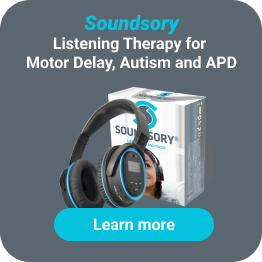How to Choose Listening Therapy Headphones for Your Child | A Comprehensive Guide
 Rachel Ann Melegrito
Rachel Ann Melegrito Occupational Therapist
August 13, 2024
Introduction
If you’re in search of a listening therapy program for your child, conducting preliminary research will provide you with an overview of various programs available, insight into how they’re performed, and, importantly, the specialized equipment they use to ensure that the auditory experience is precisely tailored to your child’s therapeutic needs. Listening therapy programs typically involve modified audio experiences designed to engage and stimulate the brain in targeted ways, forming the core of effective listening therapy. They achieve this through distinct systems and technologies. Often, they utilize specific filters and unique sound transmission systems. Still, those that allow using commercially available listening therapy headphones require them to meet stringent specifications to ensure the accurate delivery of sound stimuli. As a parent or therapist, knowing these technical details is essential in understanding how listening therapy programs operate and how they achieve therapeutic outcomes. In this article, we will explore the approved headphone options for listening therapy and discuss essential considerations you need to take into account before buying your listening therapy headphones.
Key Take-Away Messages
| How to choose the right headphones for listening therapy for your child? |
| When choosing the right listening therapy headphones for your child, the primary consideration is the listening therapy program you intend to use. Many programs are sold complete with their proprietary equipment (including headphones), while others require users to buy special quality headphones. If you’re weighing programs depending on the headphones they use, here are some important considerations: The sound transmission system used: air conduction, bone conduction, or its combination Headphone style Suitability with accompanying equipment (particularly features like impedance and frequency response) |
Try Soundsory®, a unique blend of music and movement therapy, to enhance your child’s neurodevelopment.
What are Approved Headphone Options for Listening Therapy?
There are different listening therapy programs available designed to complement conventional therapies like occupational therapy, speech therapy, and sensory integration therapy (SIT) for children with neurodevelopmental disorders like autism spectrum disorder (ASD), attention-deficit hyperactivity disorder (ADHD), and auditory processing disorder (APD or CAPD). End-users can purchase some of these programs, while others are only available to professionals. Before discussing each program’s approved headphone options or proprietary headphones designed for use in their program, here are some key features to consider:
Headphone Style (Open vs. Closed-Back Headphones)
‘Circumaural’ headphones, often called open or over-ear headphones, fully enclose the ear. Their design, which seals off the ear from external sounds, minimizes sound leakage and enhances noise cancellation, thereby offering an immersive listening experience. Additionally, these headphones are known for their comfort and often feature larger drivers and sophisticated audio technology, capable of delivering nuanced audio playback across a wide range of high frequencies.
In contrast, ‘supra-aural’ headphones, also known as on-ear or closed-back headphones, rest directly on the ears. While they are generally more compact and easier to carry around, they may offer a slightly less optimal audio quality than over-ear headphones and can cause discomfort during extended use due to their design.
For listening therapies, over-ear headphones are usually the preferred choice. For instance, ILS recommends circumaural headphones for use in their Safe and Sound Protocol (SSP). The same is true for Therapeutic Listening. Their design ensures high-quality sound delivery and provides the comfort necessary for prolonged sessions, making them ideal for therapeutic use.
Sound Transmission System
Headphones may transmit sounds via air conduction, bone conduction, or both. Air conduction refers to the traditional method of transmitting sound through air via vibrations created by speakers/drivers in each ear cup.
Bone conduction, on the other hand, offers an alternative sound transmission pathway. Instead of traveling through the air and the ear canal, it sends audio signals directly to the inner ear. This is achieved by producing vibrations conducted through the skull and facial bones. A key advantage of bone conduction is its ability to provide faster sound transmission than air conduction, bypassing the external auditory components entirely.
Certain listening therapies, such as Soundsory ®, effectively employ both air and bone conduction sound processing. This dual approach stimulates the brain and enhances sensory processing by providing multisensory input. This input engages both the auditory and vestibular systems, making it particularly beneficial for individuals with sensory processing needs. The Tomatis® Method is another example of a listening therapy that leverages a combined sound transmission system. Its TalksUp® device incorporates this dual method.
Meanwhile, the Tomatis® Method also offers a Bone Conduction Kit, a bone conduction system device that’s ideal for sensitive individuals, including babies and children under two.
Dynamic Filter
While not necessarily a feature of the headphones but of the equipment, it is crucial to consider the technology used by the listening therapy hardware you plan to use. For example, both the Tomatis® Method, Forbrain, and Soundsory® use sophisticated electronic gating in real-time to treat sounds and voices. The technology provides specialized sound treatment through its C1/C2 channels. This involves separating sounds into two channels to switch between low (relaxes the auditory system) and high frequencies (stimulates the brain).
The technology aims to capture and maintain the brain’s attention by introducing sudden shifts in tonal contrasts, which are triggered by variations in timbre and intensity. While the Tomatis® Method and Soundsory® use the technology to alter sounds, Forbrain® employs this patented dynamic filter to process the wearer’s voice. This technology modifies and enhances the voice and feeds it back to the user to enhance their auditory feedback loop.
Approved Headphones By Program
Therapeutic Listening® Vital links
In collaboration with Koss Stereophones, Therapeutic Listening® Vital Links developed specifically designed headphones for Therapeutic Listening®, called SOUNDS headphones. However, before this, Therapeutic Listening® required users to use Sennheiser 500A headphones, which the brand no longer sells.
Specifications:
- Design: circumaural open air (open back) headphones
- Frequency Response: 10Hz-28kHz
- Impedance: 52 ohms
- Sensitivity: 113 dB
- SPL Cord: Detachable 4ft with 3.5mm plugs on both ends
Integrated Listening System® (ILS)
The Integrated Listening System® (ILS) program is only available for purchase to professionals who completed ILS training. At the same time, individuals need oversight from an ILS-certified therapist during home use. ILS offers different systems, particularly the Safe and Sound Protocol (SSP) and the ILS Focus™ Series.
SSP recommends circumaural (over-the-ear) headphones instead of on-ear and earbud headphones because they effectively deliver mid-frequency sounds. Noise-canceling headphones are not recommended unless this feature can be turned off. They also allow Bluetooth headphones as long as they keep the distance to a minimum (to lower interference).
The ILS Focus™ Series uses its own ILS1000 headphones with bone conduction capability and a mini-amplifier that allows for air and bone conduction volume adjustments.
The Listening Program (TLP)
The Listening Program® (TLP) recommends using their proprietary WAVES bone conduction audio system, which comes with a high-output bone conduction transducer to provide a combination of bone and air conduction. It also has an ultra-pocket amplifier to enhance the sound of TLP.
If an individual doesn’t use WAVES, they recommend using standard circumaural headphones, either open-air or closed. These include:
– AKG K72
– AKG K361
– Sennheiser HD599
– AKG K361-BT
Like other programs, TLP doesn’t recommend in-ear, noise-canceling, or wireless headphones. They also do not recommend using those with bass booster features or those that offer bone conduction only.
Auditory integration training (AIT Berard)
Auditory integration training (AIT Berard) uses a sound modulation system known as the Auditory Integration Modulator (AIM) that modulates and filters music from CD players, LP records, or tapes. The calibration equipment is played through circumaural earphones. According to AIT, these headphones are of superlative quality and have good impedance [1].
The Tomatis® Method
The Tomatis® Method uses Tomatis ® Infinite headphones. Here are its specifications:
- Gating Tomatis system for instant voice processing
- Offers 3 universal listening programs
- Has Bluetooth mode
- With a built-in transducer (vibrator) for dual sound transmission (air and bone conduction)
- Option: HD microphone function for active voice feedback treatment
- Auditory laterality settings
The Samonas Sound Therapy
There is limited information on the equipment used by Samonas Sound Therapy other than the program using a CD player or the Samonas app, which is played through professional headphones.
What are Other Important Considerations?
Matching the audio source of a listening therapy program with headphones that have the correct impedance or resistance (measured in ohms) is crucial, as it significantly impacts the quality of sound produced. Generally, headphones with higher impedance deliver better sound quality. Using headphones with lower impedance than recommended by the program can adversely affect the therapy’s effectiveness. Additionally, adhering to the program’s specified frequency response, or the range of frequencies the headphones can produce, is crucial. For instance, TLP recommends headphones with a frequency range of 22,000 to 23,000 Hz. This ensures that sounds, clicks, and frequency ranges found in sounds and voices in listening therapy programs will be heard.
Moreover, wired headphones are often preferred over wireless ones in listening therapies because they provide superior sound quality. This advantage stems from their ability to transmit uncompressed audio data, avoiding the interference or signal loss that can occur with Bluetooth or Wi-Fi connections.
Buying and Setup Tips for Parents
Proprietary headphones for listening therapy programs are typically available exclusively on the program’s official website. If a program recommends commercially available headphones, these can usually be purchased directly from the manufacturer. Additionally, most programs provide detailed guidelines for the correct setup and use of their equipment, which are accessible on their website. If not, you should contact their customer support.
Regarding volume levels, it’s crucial to maintain them at a conversational level. This means the volume should be set so the child does not have to raise their voice above their normal speaking level to communicate. The Occupational Safety and Health Administration (OSHA) suggests keeping volumes below 85 decibels to protect hearing [2]. Typically, the volume in these programs is set between 45 to 55 decibels, considering that normal conversational speech is about 70 decibels.
For proper positioning, check the L/R marks on each ear. At the same time, make sure that the headband is in direct contact with the top of the head. This positioning is especially crucial for headphones with bone conduction. To maintain the headphones securely in place during use, especially with active children, elastic headbands, such as those included in the Soundsory set, can be used. This ensures that the headphones remain in the optimal position for the duration of the therapy session.
Conclusion
Choosing the right listening therapy headphones for your child involves understanding the specific needs of the listening therapy program and the technology behind it. Each listening therapy program, with its particular technologies and approaches, may recommend different headphones. These could range from headphone styles, with varying sound transmission systems like air or bone conduction, and with the specifications to deliver sounds from their proprietary devices.
The quality of the listening therapy headphones can significantly impact the therapeutic outcome. Parents should also consider the child’s ease of use and comfort, as well as the headphone’s adherence to safety standards, such as volume control, to ensure a positive and effective listening therapy experience.
FAQ
Does listening therapy work for ADHD?
Many children with ADHD have sensory processing issues. Listening therapy programs provide multisensory stimulation that can help stimulate the child’s sensory system and promote regulation. At the same time, listening therapies were found to improve different skill deficits seen in those with ADHD, including attention, hyperactivity, and impulsivity, according to a 2021 case study report [3].
References
- AITInstitute. (n.d.). Headphone & Noise Cancelling Device Precautions After AIT. https://www.aitinstitute.org/ait_and_headphones.htm
- Occupational Safety and Health Administration (OSHA). (n.d.). Occupational noise. https://www.osha.gov/noise
- Dursun, P., Fidan, U. & Karayagiz, S. Probable role of listening therapy in the management of ADHD symptoms: Three case studies. Curr Psychol 40, 4219–4234 (2021). https://doi.org/10.1007/s12144-021-01419-x



